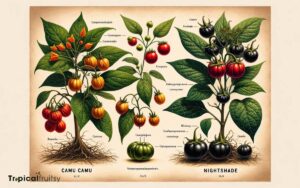What Is a Camu Camu? Unlocking Nature’s Secret!
Camu camu is a nutrient-dense berry originating from the Amazon rainforest, renowned for its exceptionally high vitamin C content.
This small, tart fruit is also laden with antioxidants and has been linked to numerous health benefits, including immune system support and chronic disease prevention.
The growing popularity of camu camu has led to its inclusion in various health-conscious diets, commonly in powdered form, which is easy to integrate into smoothies, desserts, and an array of culinary creations.
The camu camu berry, Myrciaria dubia, is often hailed as a superfood due to its rich nutritional composition. The fruit’s claim to fame is primarily its vitamin C content, which surpasses that of nearly any other food source.
Here’s why the camu camu berry stands out:
Discover camu camu, the Amazonian superfruit with unparalleled vitamin C levels, for your next nutritional powerhouse addition.

Key Takeaway
Camu Camu: A Nutritional Powerhouse Unveiled
| Nutrient | Amount per 100g | % Daily Value |
|---|---|---|
| Vitamin C | 2,145 mg | 3575% |
| Antioxidants | High levels | — |
| Fiber | 1.55 g | 6% |
| Carbohydrates | 5.9 g | 2% |
| Protein | 0.4 g | <1% |
| Fat | 0.2 g | <1% |
| Calcium | 15.7 mg | 2% |
| Iron | 0.53 mg | 3% |
Unveiling the Camu Camu Berry
The camu camu berry, often hailed as a superfruit, is a small, sour berry native to the Amazon rainforest. It’s recognized for its remarkably high vitamin C content, sometimes boasting as much as 60 times more than an orange.
This potent antioxidant plays a crucial role in immune function, skin health, and the repair of tissues.
Research suggests that camu camu could also have anti-inflammatory properties, thanks to its dense concentration of flavonoids and other phytochemicals.
Scientists are exploring its potential benefits for chronic diseases, including diabetes and cardiovascular illnesses. While it’s not a cure-all, incorporating camu camu into a balanced diet can contribute to overall health.
As it gains popularity, nutrition-minded individuals are increasingly seeking it out for its nutritional prowess.
Nutritional Profile Breakdown
Why should you consider adding camu camu to your diet?
Its nutritional profile is impressive, offering a rich array of vitamins, minerals, and antioxidants that can support various aspects of health.
Camu camu boasts one of the highest concentrations of vitamin C found in any fruit, with as much as 60 times more than an orange.
This potent vitamin serves as a powerful antioxidant, supports the immune system, and aids in collagen production for healthy skin.
Beyond vitamin C, camu camu contains valuable amino acids like valine, leucine, and serine, which are essential for muscle and tissue health.
It also offers a suite of B vitamins, potassium, calcium, zinc, magnesium, and manganese. These nutrients contribute to nerve function, energy levels, and bone strength.
Health Benefits Explored
How does camu camu contribute to your health?
Packed with vitamin C, camu camu offers potent antioxidant properties, which may help neutralize free radicals and reduce the risk of chronic diseases.
This superfruit supports a robust immune system, aiding in the prevention of colds and infections. Its anti-inflammatory effects can alleviate conditions like arthritis, though more research is needed to fully understand this benefit.
Camu camu also contains health-promoting compounds such as flavonoids, which have been linked to heart health.
Furthermore, the high vitamin C content promotes collagen production, essential for healthy skin, bones, and blood vessels.
While it’s not a cure-all, incorporating camu camu into a balanced diet could certainly boost overall well-being.
Culinary Uses and Recipes
Camu camu’s nutrient-rich profile extends beyond health advantages to versatile culinary applications. It is often found in smoothies, jams, and desserts for a tangy vitamin C boost.
The fruit’s high acidity and unique flavor profile make it a favored ingredient for chefs and home cooks alike. They are eager to infuse a burst of brightness into their dishes.
When using camu camu in recipes, it’s typically available as a powder or puree due to the fruit’s perishable nature.
This powder can be seamlessly incorporated into vinaigrettes or sprinkled over yogurt and oatmeal. In beverages, a teaspoon of camu camu powder adds a zesty note to juices or cocktails.
For sweet treats, camu camu is used in energy bars, ice creams, and even baked goods. It complements other fruity flavors and enhances the nutritional value of desserts.
Sourcing and Sustainability Issues
Where does camu camu come from, and what’re the sustainability challenges associated with its harvest?
Native to the Amazon rainforest, camu camu is primarily sourced from Peru and Brazil. Its rising popularity as a superfood has both positive and negative effects on the environment and local communities.
- Overharvesting: Increased demand can lead to overharvesting, depleting natural stocks.
- Habitat Disruption: Harvesting methods may disturb the delicate rainforest ecosystem.
- Economic Pressure: Local economies may become dependent on camu camu, risking instability.
- Cultivation Shifts: Farmers might convert land for camu camu cultivation, affecting biodiversity.
- Climate Change Impact: Changing weather patterns can threaten the natural habitat of camu camu.
Striking a balance between demand and sustainable practices is crucial for the future of camu camu.
Conclusion
As the dawn breaks on the horizon of superfruits, camu camu shines brightly with its rich vitamin C content and potential health benefits. It’s a nutrient-packed powerhouse that can zing up any diet.
Whether tossed into smoothies or sprinkled over desserts, its versatility in the kitchen is as vast as the Amazon itself.
Yet, as we relish its bounties, mindful sourcing remains crucial to ensure this natural gem is preserved for future generations to savor.





